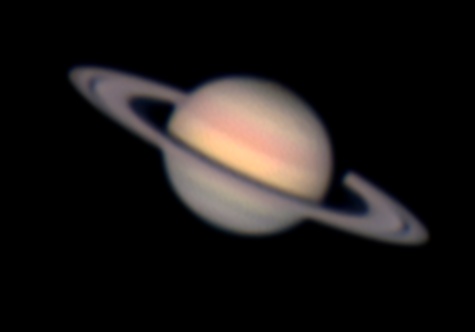
This image shows the planet Saturn with its rings tilted at about 10 degrees. The tilt of Saturn's rings varies between 0 degrees and plus or minus 27 degrees as Saturn completes its 29.5-year orbit around the Sun. The rings will appear edge-on in September 2009, at which time the rings will appear to vanish for a brief period of time as seen from Earth. As compared to our view in early 2004, when the rings were at their maximum tilt, you can now see that the planet spins so fast it is ellipsoid in shape. Saturn is only 91% as tall as it is wide. In this image, the planet's southern hemisphere is at the top. After the ring plane crossing in September 2009, we will be able to see Saturn's entire northern hemisphere. A giant white storm often erupts when summer begins in the northern hemisphere.
Jupiter, Neptune, and Uranus also have rings. However, their rings are very thin and faint, and are not visible from Earth. Saturn is a gas giant, and has cloud bands like Jupiter. Saturn is the second largest planet in the solar system. However, Jupiter is much larger than any of the other planets, and all of the other planets could fit inside Jupiter with room to spare.
This image was taken using a ToUcam Pro web cam on an RCOS 24-inch telescope with a 2x barlow. The image was taken with the 24-inch telescope at the University of Arizona SkyCenter on Mt. Lemmon, Arizona, operated by Adam Block. Adam conducts a nightly observing program at the Mount Lemmon SkyCenter with this telescope. For more information concerning the observing program, contact Adam Block. When this image was taken, the seeing was poor, and a near-full moon (90.5% illuminated) was only 20 degrees away from Saturn.
Saturn
Constellation: Leo
RA: 10h 18m 16s Dec: +12d 30' 08"
April 17, 2008
Image by Sid Leach and Adam Block
Mt. Lemmon, Arizona
Recent Images.
Complete list of images.
Description of equipment used to acquire images.
Home
Feedback and comments should go to Sid